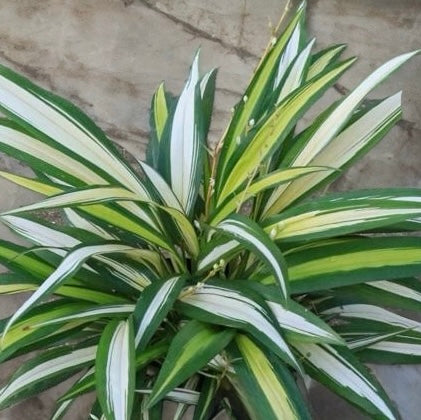Chlorophytum capense 'Tricolor' 75mm Pot
- Regular price
-
$25.00 - Regular price
-
- Sale price
-
$25.00
-
Hurry, only 1 item left in stock!
Couldn't load pickup availability
Shipping information


Product Details
Welcome to Plant&Leaf and our range of family grown plants. The first photo serves as a representative display, showcasing the beauty of a mature plant. The second photo provides a sample of a single plant from the current batch available. Please note the Pot size displayed on the heading of each product.
All of our plants are grown outdoors in nature and are exposed to the natural elements. Sometimes this means a leaf could have been chewed here and there or have a blemish or two – but we do our best to send the best plants we can on every order.
Chlorophytum, commonly known as spider plant, is a popular and easy-to-care-for houseplant. Here are some guidelines to help you keep your Chlorophytum healthy and thriving:
-
Light: Spider plants thrive in bright, indirect light. They can tolerate some direct sunlight, but too much can scorch their leaves. Place your spider plant near a window where it can receive plenty of natural light without being exposed to direct sun rays.
-
Watering: Spider plants prefer consistently moist soil, but they are susceptible to root rot if overwatered. Allow the top inch of soil to dry out between waterings, then water thoroughly until water drains from the bottom of the pot. In winter, reduce watering frequency, as the plant's growth slows down.
-
Humidity: Spider plants can tolerate average indoor humidity levels, but they appreciate a bit of extra humidity, especially during the dry winter months. You can increase humidity by misting the plant regularly, placing it on a humidity tray filled with water and pebbles, or using a room humidifier.
-
Temperature: Spider plants prefer temperatures between 15-24°C. They can tolerate slightly cooler temperatures, but avoid exposing them to drafts or sudden temperature fluctuations.
-
Soil: Plant spider plants in well-draining potting soil. A mixture of peat moss, perlite, and coarse sand works well. Ensure the pot has drainage holes to prevent waterlogging.
-
Fertilization: Feed your spider plant with a balanced liquid fertilizer diluted to half strength every 2-4 weeks during the growing season (spring and summer). Reduce fertilization to once a month or less during fall and winter.
-
Pruning: Spider plants produce long, arching stems with baby plantlets (spiderettes) at the ends. You can prune these stems back to maintain the plant's shape and encourage new growth. You can also propagate the baby plantlets by rooting them in water or planting them directly in soil.
-
Pests and Diseases: Spider plants are relatively resistant to pests and diseases, but they can occasionally attract spider mites, aphids, or mealybugs. Inspect your plant regularly for signs of pests, and treat infestations promptly with insecticidal soap or neem oil.
-
Repotting: Repot your spider plant every 1-2 years, or when it becomes root-bound. Choose a slightly larger pot with drainage holes and fresh potting soil.
By following these care tips, you can enjoy a healthy and thriving spider plant in your home or office space





